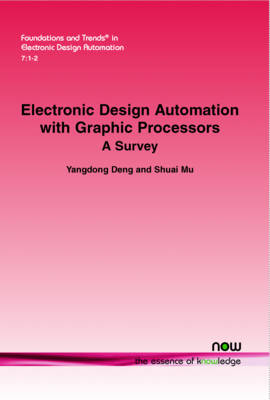
Electronic Design Automation with Graphic Processors
A Survey
Seiten
2013
now publishers Inc (Verlag)
978-1-60198-680-1 (ISBN)
now publishers Inc (Verlag)
978-1-60198-680-1 (ISBN)
Offers a timely state-of-the-art review of the existing literature on GPU-based EDA computing. Considering the substantial diversity of VLSI Computer Aided Design (CAD) algorithms, the book puts forward a taxonomy of EDA computing patterns, which can be used as basic building blocks to construct complex EDA applications.
Today's Integrated Circuit (IC) architects depend on Electronic Design Automation (EDA) software to conquer the overwhelming complexity of Very Large Scale Integrated (VLSI) designs. As the complexity of IC chips is still fast increasing, it is critical to maintain the momentum towards growing productivity of EDA tools. On the other hand, single-core Central Processing Unit (CPU) performance is unlikely to see significant improvement in the near future. It is thus essential to develop highly efficient parallel algorithms and implementations for EDA applications so that their overall productivity can continue to increase in a scalable fashion.
Among various emergent parallel platforms, Graphics Processing Units (GPUs) now offer the highest single-chip computing throughput. A large body of research has therefore been dedicated to accelerating EDA applications with GPUs. Electronic Design Automation with Graphic Processors is a timely state-of-the-art review of the existing literature on GPU-based EDA computing. Considering the substantial diversity of VLSI Computer Aided Design (CAD) algorithms, it puts forward a taxonomy of EDA computing patterns, which can be used as basic building blocks to construct complex EDA applications. GPU-based acceleration techniques for these patterns are then reviewed, and, building on this foundation, it goes on to survey recent works on building efficient data-parallel algorithms and implementations to unleash the power of GPUs for EDA applications.
Today's Integrated Circuit (IC) architects depend on Electronic Design Automation (EDA) software to conquer the overwhelming complexity of Very Large Scale Integrated (VLSI) designs. As the complexity of IC chips is still fast increasing, it is critical to maintain the momentum towards growing productivity of EDA tools. On the other hand, single-core Central Processing Unit (CPU) performance is unlikely to see significant improvement in the near future. It is thus essential to develop highly efficient parallel algorithms and implementations for EDA applications so that their overall productivity can continue to increase in a scalable fashion.
Among various emergent parallel platforms, Graphics Processing Units (GPUs) now offer the highest single-chip computing throughput. A large body of research has therefore been dedicated to accelerating EDA applications with GPUs. Electronic Design Automation with Graphic Processors is a timely state-of-the-art review of the existing literature on GPU-based EDA computing. Considering the substantial diversity of VLSI Computer Aided Design (CAD) algorithms, it puts forward a taxonomy of EDA computing patterns, which can be used as basic building blocks to construct complex EDA applications. GPU-based acceleration techniques for these patterns are then reviewed, and, building on this foundation, it goes on to survey recent works on building efficient data-parallel algorithms and implementations to unleash the power of GPUs for EDA applications.
1: Introduction 2: GPU Architecture and Programming Model 3: EDA Computing Patterns 4: Accelerating Key Design Patterns on GPUs 5: GPU Accelerated EDA Applications 6: Conclusion and Future Work 7: Acknowledgements. References
| Reihe/Serie | Foundations and Trends® in Electronic Design Automation |
|---|---|
| Verlagsort | Hanover |
| Sprache | englisch |
| Maße | 156 x 234 mm |
| Gewicht | 275 g |
| Themenwelt | Mathematik / Informatik ► Informatik ► Theorie / Studium |
| Informatik ► Weitere Themen ► CAD-Programme | |
| Technik ► Elektrotechnik / Energietechnik | |
| ISBN-10 | 1-60198-680-7 / 1601986807 |
| ISBN-13 | 978-1-60198-680-1 / 9781601986801 |
| Zustand | Neuware |
| Haben Sie eine Frage zum Produkt? |
Mehr entdecken
aus dem Bereich
aus dem Bereich
Buch | Softcover (2023)
Beuth (Verlag)
99,00 €
Einführung in die Geometrische Produktspezifikation
Buch | Softcover (2023)
Europa-Lehrmittel (Verlag)
20,70 €


